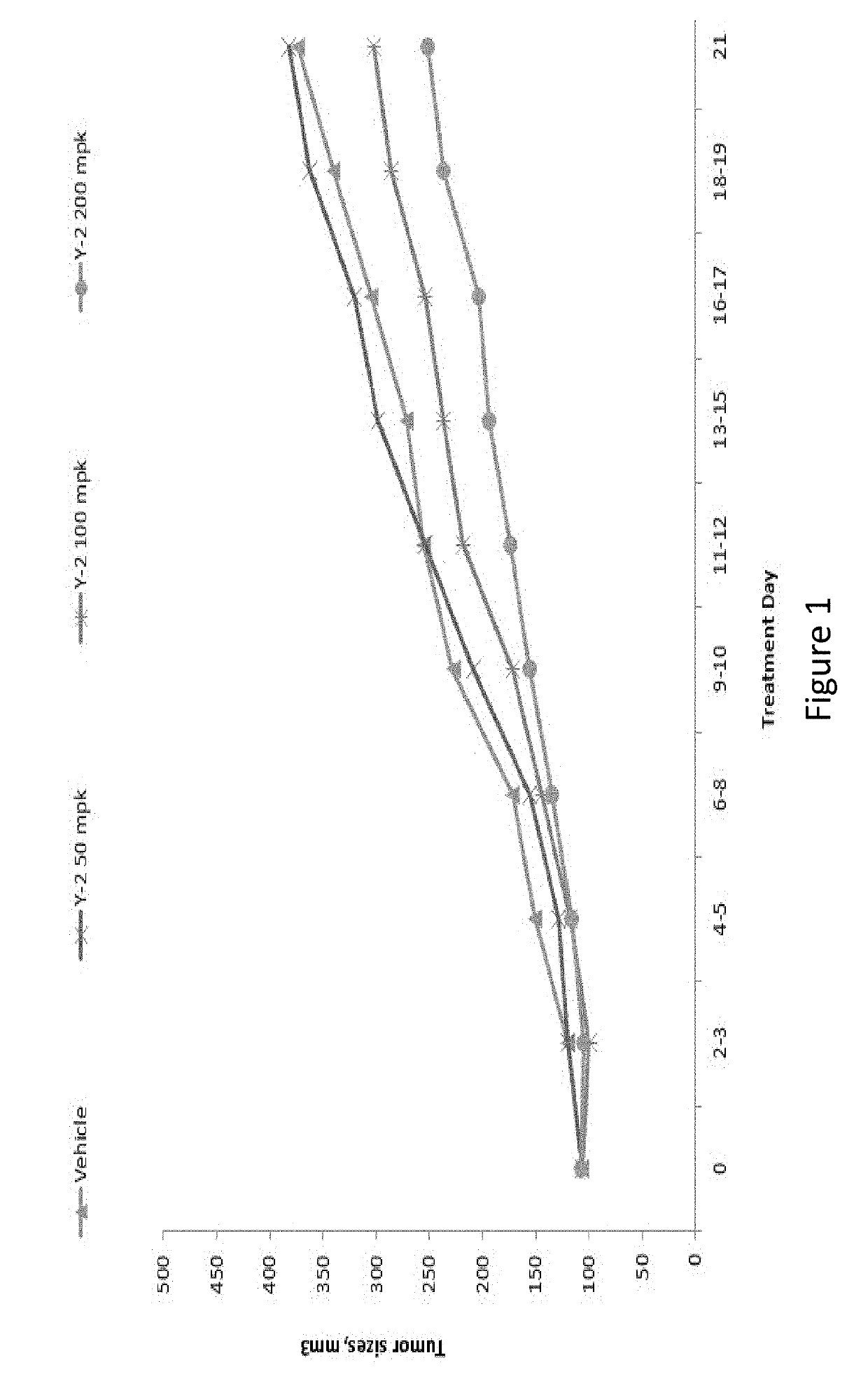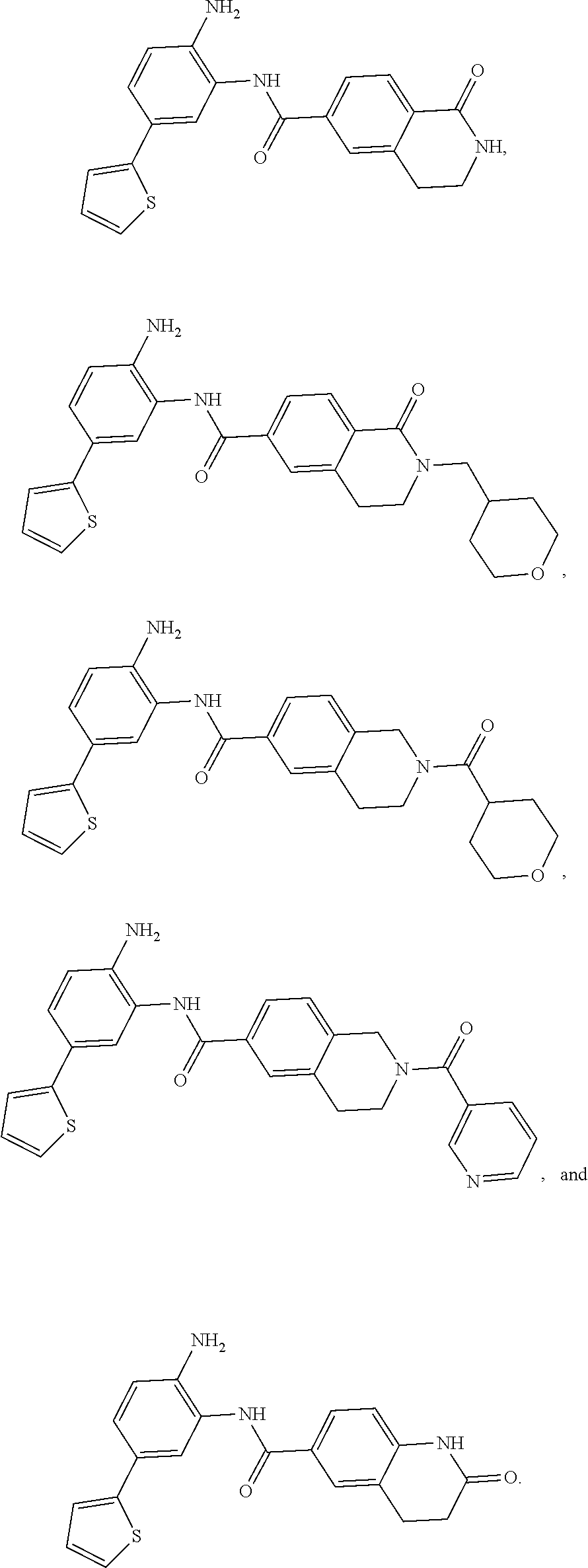Quinoline and Isoquinoline Based HDAC Inhibitors and Methods of Use Thereof
a technology of hdac inhibitors and quinolines, which is applied in the field of hdac inhibitors based on quinolines and isoquinolines, can solve the problems of poor isoform selectivity, poor prognostic markers, and mice lacking hdac6 exhibit moderately impaired immune response and bone homeostasis, and significantly correlate with poor prognostic markers
- Summary
- Abstract
- Description
- Claims
- Application Information
AI Technical Summary
Benefits of technology
Problems solved by technology
Method used
Image
Examples
example 1
o-5-(thiophen-2-yl)phenyl)-1-oxo-1,2,3,4-tetrahydroisoquinoline-6-carboxamide
[0174]
[0175]Example 1 was synthesized according to Scheme 1. 1H NMR (DMSO d6, 400 MHz): δ (ppm) 2.99-3.02 (t, 2H), 3.41-3.44 (m, 2H), 7.11-7.23 (m, 2H), 7.43-7.54 (m, 3H), 7.69 (s, 1H), 7.98-8.02 (m, 3H), 8.12 (s, 1H), 10.36 (s, 1H). LC-MS showed a single peak with purity >95% based on UV absorption at 254 nm. MS: C20H17N3O2S. Calculated (M+H): 364, obtained MS: 364.
Example 2. N-(2-amino-5-(thiophen-2-yl)phenyl)-1-oxo-2-((tetrahy dro-2H-pyran-4-yl)methyl)-1,2,3,4-tetrahydroisoquinoline-6-carboxamide
[0176]
[0177]Example 2 was synthesized according to Scheme 2. 1H-NMR (400 MHz, DMSO-d6+10% D2O): δ 7.83 (d, J=1.8 Hz, 1H), 7.81 (s, 1H), 7.45 (d, J=12.5 Hz, 2H), 7.38 (s, 1H), 7.18 (m, 2H), 7.03 (d, J=0.9 Hz, 1H), 6.86 (d, 2.0 Hz, 1H), 3.99 (m, 4H), 3.61 (t, J=1.6 Hz, 2H), 3.46 (d, J=1.9 Hz, 2H), 3.40 (t, J=0.5 Hz, 2H), 3.34 (t, J=0.5 Hz, 2H), 2.04 (m, 1H), 1.44 (m, 2H). LC-MS showed a single peak with purity >95%...
example 2
ndent Inhibition of HDAC Compounds Prepared in Enzymatic Assays, and IC50 Values of Synthesized and Reference Compounds in HDAC
Enzymatic Assays
Materials and Methods: Enzymes
[0184]Human HDAC1 (GenBank Accession No. NM_004964), full-length with a C-terminal His-tag and a C-terminal FLAG-tag, MW=56 kDa, was expressed in a baculovirus expression system.
[0185]Human HDAC2 (GenBank Accession No. NM_001527), full-length with a C-terminal His-tag, MW=56 kDa, was expressed in a baculovirus expression system.
[0186]Complex of human HDAC3 (GenBank Accession No. NM_003883), full-length with a C-terminal His tag, MW=49.7 kDa, and human NCOR2 (amino acid 395-489) (GenBank Accession No. NM_006312), N-terminal GST tag, MW=37.6 kDa, was co-expressed in a baculovirus expression system.
[0187]Human HDAC4 (GenBank Accession No. NM_006037), amino acids 627-1085 with a N-terminal GST tag, MW=75.2 kDa, was expressed in a baculovirus expression system.
[0188]Human HDAC5 (GenBank Accession No. NM_005474), full-...
example 3
harmacokinetics studies of N-(2-amino-5-(thiophen-2-yl)phenyl)-2-oxo-1,2,3,4-tetrahydroquinoline-6-carboxamide in mice
[0214]In vivo PK (pharmacokinetics) studies were run at Scripps Florida DMPK Core facility. Mouse plasma PK data was obtained using the compound of Example 5 (N-(2-amino-5-(thiophen-2-yl)phenyl)-2-oxo-1,2,3,4-tetrahydroquinoline-6-carboxamide)
Materials and Methods
Compound Example 5 Mouse Plasma PK
[0215]Dose: 1 mg / kg intravenous (IV), 7 mg / kg oral dosing (PO)
[0216]Formulation: 0.1 mg / mL (IV) and 1 mg / mL (PO) solution in 10 / 10 / 80 DMSO / Tween80 / Water
[0217]Mice Info: Male C57 Bl / 6J
Results
[0218]Plasma PK were evaluated in mice after administration of compound Example 5. Following IV administration, the PK properties show a good half-life (T1 / 2) of 1.5 h, high AUC (8.5 μM·h), a low clearance, and a low volume (Table 2). The properties are also fair by oral dosing (PO dosing), with a good half-life (2.7 h) and good AUC (area under the curve) (˜11-12 μM·h), and a reasonable b...
PUM
| Property | Measurement | Unit |
|---|---|---|
| particle size | aaaaa | aaaaa |
| w/w | aaaaa | aaaaa |
| temperature | aaaaa | aaaaa |
Abstract
Description
Claims
Application Information
 Login to View More
Login to View More - R&D
- Intellectual Property
- Life Sciences
- Materials
- Tech Scout
- Unparalleled Data Quality
- Higher Quality Content
- 60% Fewer Hallucinations
Browse by: Latest US Patents, China's latest patents, Technical Efficacy Thesaurus, Application Domain, Technology Topic, Popular Technical Reports.
© 2025 PatSnap. All rights reserved.Legal|Privacy policy|Modern Slavery Act Transparency Statement|Sitemap|About US| Contact US: help@patsnap.com



